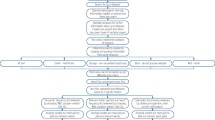Abstract
Background Healthcare information is increasingly being sought on the Internet. Ischaemic heart disease (IHD) poses a significant health burden. Concern often arises for patients with IHD when undergoing dental treatment, leading to online searching for relevant healthcare information.
Objective To evaluate the readability and quality of webpages regarding IHD and dental treatment.
Materials and methods Three searches were performed on the Google search engine. The first hundred results of each search were collated and exclusion criteria applied. The remaining 66 webpages were categorised. Readability was assessed using the FRES and SMOG readability tools. Quality was assessed using the PEMAT questionnaire, the JAMA benchmarks and the Health On the Net (HON) seal.
Results Most examined webpages were commercial. Readability of 90.1% of webpages was deemed fairly to very difficult. Understandability and actionability scores were generally below the comprehension level of the general population. Less than 50% of websites achieved the authorship, attribution and disclosure JAMA benchmarks. Only 12.1% of websites displayed the HON seal.
Conclusions Online health information related to IHD and dental treatment is generally too difficult for the average individual to read, understand, or act upon, and may be of questionable quality. Given the low health literacy rates among the general population, future revisions of educational materials by non-commercial sources regarding IHD and dental treatment are warranted, in order to ensure online health information is understandable and of genuine benefit to patients and/or their carers.
This is a preview of subscription content, access via your institution
Access options
Subscribe to this journal
Receive 24 print issues and online access
$259.00 per year
only $10.79 per issue
Buy this article
- Purchase on Springer Link
- Instant access to full article PDF
Prices may be subject to local taxes which are calculated during checkout





Similar content being viewed by others
References
Schoen F J, Mitchell R N. The Heart. In Kumar V, Abbas A K, Fausto N, Mitchell R N (eds) Robbins Basic Pathology. 8th ed. pp 388-398. Philadelphia: Elsevier Saunders, 2007.
Montalescot G. 2013 ESC guidelines on management of stable coronary artery disease. Eur Heart J 2013; 34: 2949-3003.
Kannam J P, Aroesty J M, Gersh B J. Chronic coronary syndrome: overview of care. 2015. Available online at http://www.uptodate.com/contents/stableischemicheartdiseaseoverviewofcare (accessed April 2018).
World Health Organisation. The top 10 causes of death. 2017. Available at https://www.who.int/en/news-room/fact-sheets/detail/the-top-10-causes-of-death (accessed April 2018).
Andreassen H, Bujnowska-Fedak M, Chronaki C et al. European citizens' use of E-health services: A study of seven countries. BMC Public Health 2007; DOI: 10.1186/1471-2458-7-53.
Fox S. E-patients with a disability or chronic disease. 2007. Available at https://www.pewresearch.org/internet/2007/10/08/e-patients-with-a-disability-or-chronic-disease/ (accessed April 2018).
Ni Riordain R, McCreary C. Dental patients' use of the Internet. Br Dent J 2009; 207: 583-586.
Yin H S, Johnson M, Mendelsohn A L, Abrams M A, Sanders L M, Dreyer B P. The health literacy of parents in the United States: a nationally representative study. Paediatrics 2009; DOI: 10.1542/peds.2009-1162E.
Levy H, Janke A T, Langa K M. Health literacy and the digital device among older Americans. J Gen Intern Med 2015; 30: 284-289.
Moser C. Improving literacy and numeracy: a fresh start. 1999. Available online at http://www.educationengland.org.uk/documents/moser1999/moser-report.html (accessed February 2020).
Wigley C. Santa's little helpers: a novel approach to developing patient information leaflets. Br Med J 2017; DOI: 10.1136/bmj.j5565.
National Centre for Education Statistics. The Health Literacy of America's Adults: Results from the 2003 National Assessment of Adult Literacy. 2006. Available at https://nces.ed.gov/pubs2006/2006483.pdf (accessed April 2018).
U.S. Department of Health and Human Services. America's Health Literacy: Why We Need Accessible Health Information. 2008. Available online at https://health.gov/our-work/health-literacy/health-literate-care-model/literature (accessed April 2018).
Weiss B. Health Literacy: A Manual for Clinicians. Chicago, IL: American Medical Association Foundation and American Medical Foundation, 2003. Available at http://lib.ncfh.org/pdfs/6617.pdf (accessed February 2020).
Chestnutt I G, Reynolds K. Perceptions of how the Internet has impacted on dentistry. Br Dent J 2006; 200: 161-165.
Aucar J, Doarn C, Sargsyan A, Samuelson D, Odonnell M, DeBakey M. Use of the Internet for Long-Term Clinical Follow-Up. Telemed J 1998; 4: 371-374.
Kirthi V, Modi B N. Coronary angioplasty and the internet: what can patients searching online expect to find? J Interv Cardiol 2012; 25: 476-481.
Ni Riordain R, McCreary C. Head and neck cancer information on the internet: type, accuracy and content. Oral Oncol 2009; 45: 675-677.
Best J, Muzaffar J, Mitchell Innes A. Quality of information available via the internet for patients with head and neck cancer: are we improving? Eur Arch Otorhinolaryngol 2015; 272: 3499-3505.
Wiriyakijja P, Fedele S, Porter S, Ni Riordain R. Web-based information on the treatment of oral leukoplakia - quality and readability. J Oral Pathol Med 2016; 45: 617-620.
Ni Riordain R, Hodgson T. Content and quality of website information on the treatment of oral ulcers. Br Dent J 2014; DOI: 10.1038/sj.bdj.2014.886.
Wong K, Gilad A, Cohen M, Kirke D, Jalisi S. Patient education materials assessment tool for laryngectomy health information. Head Neck 2017; 39: 2256-2263.
Beaunoyer E, Arsenault M, Lomanowska A M, Guitton M J. Understanding online health information: Evaluation, tools, and strategies. Patient Educ Couns 2017; 100: 183-189.
Ley P, Florio T. The use of readability formulas in health care. Psychol Health Med 1996; 1: 7-28.
Flesch R. A new readability yardstick. J Appl Psychol 1948; 32: 221-233.
Wang L W, Miller M J, Schmitt M R, Wen F K. Assessing readability formula differences with written health information materials: application, results, and recommendations. Res Social Adm Pharm 2013; 9: 503-516.
Shoemaker S J, Wolf M S, Brach C. Development of the Patient Education Materials Assessment Tool (PEMAT): a new measure of understandability and actionability for print and audiovisual patient information. Patient Educ Couns 2014; 96: 395-403.
Silberg W M, Lunderberg G D, Musacchio R A. Assessing, controlling, and assuring the quality of medical information on the Internet: Caveant lector et viewor - Let the reader and viewer beware. JAMA 1997; 277: 1244-1245.
Health On the Net. Health On the Net Foundation. Geneva; 2017. Available at https://www.hon.ch/Global/contact2.html (accessed April 2018).
Brossard D. New media landscapes and the science information consumer. Proc Natl Acad Sci U S A 2013; DOI: 10.1073/pnas.1212744110.
Arsenault M, Blouin M J, Guitton M J. Information quality and dynamics of patients' interactions on tonsillectomy web resources. Internet Interv 2016; 4: 99-104.
Ayonrinde O. Patients in cyberspace: information or confusion? Postgrad Med J 1998; 74: 449-450.
Sacchetti P, Zvara P, Plante M. The internet and patient education - resources and their reliability: focus on a select urologic topic. Urology 1999; 53: 1117-1120.
NHS. Toolkit for producing patient information. 2003. Available at https://www.uea.ac.uk/documents/246046/0/Toolkit+for+producing+patient+information.pdf (accessed February 2020).
Shoemaker S J, Wolf M S, Brach C. The Patient Education Materials Assessment Tool (PEMAT) and User's Guide: An Instrument To Assess the Understandability and Actionability of Print and Audiovisual Education Materials. 2014. Available at https://www.ahrq.gov/sites/default/files/publications/files/pemat_guide.pdf (accessed February 2020).
Office of Disease Prevention and Health Promotion. Health Literacy Online. 2nd ed. 2016. Available at https://health.gov/healthliteracyonline/ (accessed December 2019).
Health literacy: report of the Council on Scientific Affairs. Ad Hoc Committee on Health Literacy for the Council on Scientific Affairs, American Medical Association. JAMA 1999; 281: 552-557.
Laurent M R, Vickers T J. Seeking health information online: does Wikipedia matter? J Am Med Inform Assoc 2009; 16: 471-479.
Berkman N, Sheridan S, Donahue K, Halpern D, Crotty K. Low health literacy and health outcomes: an updated systematic review. Ann Intern Med 2011; 155: 97-107.
National Institutes of Health. How to Write EasytoRead Health Materials. 2017.
Health On the Net. The certification process step by step. 2017. Available at https://www.hon.ch/HONcode/Webmasters/StepByStep/StepByStep.html (accessed April 2018).
Author information
Authors and Affiliations
Corresponding author
Rights and permissions
About this article
Cite this article
Leung, JY., Ni Riordain, R. & Porter, S. Readability and quality of online information regarding dental treatment for patients with ischaemic heart disease. Br Dent J 228, 609–614 (2020). https://doi.org/10.1038/s41415-020-1331-2
Published:
Issue Date:
DOI: https://doi.org/10.1038/s41415-020-1331-2
This article is cited by
-
Quality and readability of web-based Arabic health information on periodontal disease
BMC Medical Informatics and Decision Making (2021)
-
Contemporary management of advanced midface malignancy in the age of Instagram - a parallel surgical and patient's perspective
British Dental Journal (2021)



